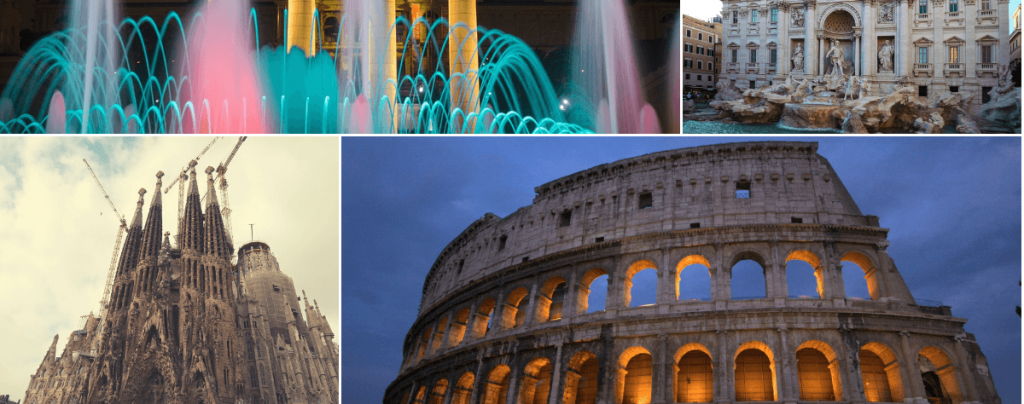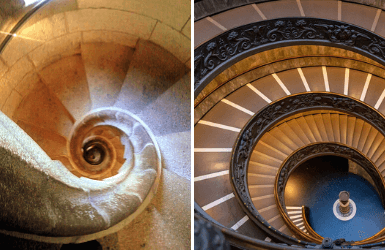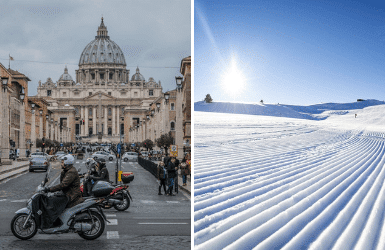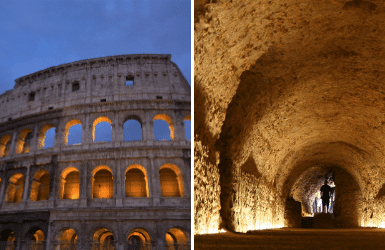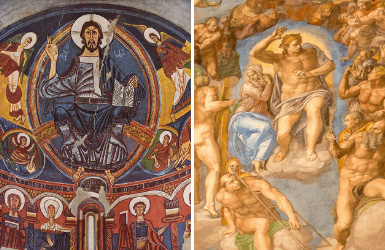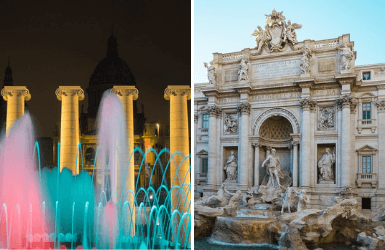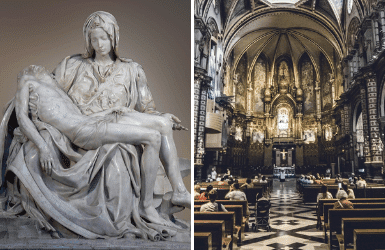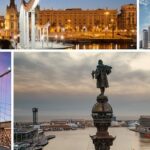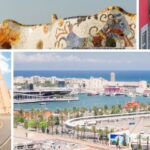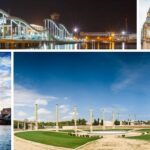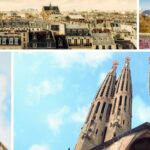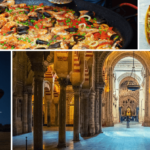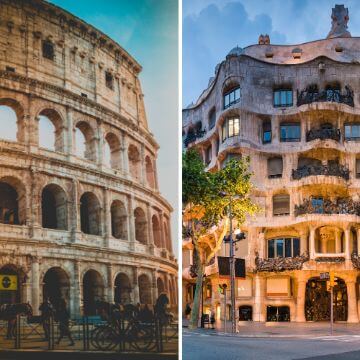
Rome VS Barcelona Highlights
BARCELONA VS ROME TRAVEL
In our series of Barcelona versus the World, today we are talking a difficult enterprise. Because how can any city compare to the eternal Rome, no matter how cool the other city might be?
But this is not to decide what city is the absolute best. This is to help you figure out the little nuances that will make one of them a better choice for you.
Should you go to Rome or Barcelona?
1
Geography and Population
The Comune or city of Rome is huge. Its 1,285 km2 (496.3 sq mi) of surface largely exceeds the timid 100 km2 (39 sq mi) of Barcelona. However Barcelona is way more densely populated, with 1,600,00 inhabitants. Rome only has about one million more despite being much larger: 2,860,000 people. But Rome receives 3 million more visitors than Barcelona: 9.5 versus 6.5.
The distances are bigger in Rome. The Vatican, the Galleria Borghese and the Colosseum make a triangle that encompasses most top tourist sites. Getting from one of them to the other can take 40 to 60 minutes walk. And unfortunately, buses and the only 3 subway lines don’t save you much time really.
Instead the sites of the Barcelona city center are mostly found between the Old Port and Diagonal avenue, which is roughly 30 minutes walk, with the L3 green line taking you from Columbus monument to La Pedrera in 8 minutes. That makes Barcelona a city that is comfortable to walk. And its efficient subway system, with 8 lines and 100 more stations that Rome’s, make it easy to get to the sites that are outside of the city center. Mainly Sagrada Familia, Park Guell, Montjuic Hill and the FC Barcelona stadium.
Finally, Barcelona is located by the Mediterranean sea, and its cruise port is right next to the city. Instead, the Civitavechia cruise port is located 80km (50 miles) away from Rome. Rome does have a river, though: the Tiber.
2
Small countries
In the center of Rome there’s a small independent country: the Vatican. Their head of state is also a religious leader: the Catholic Pope. The country is only 0.49 km2 (0.19 sq mi) with around 825 inhabitants, but it holds one of the most impressive museum collections in the world, the Vatican Museums. Tourists flock there to visit the Basilica di San Pietro and the Sixtine Chapel.
But did you know there’s another tiny country just 2 hours drive from Barcelona? It’s called Andorra and it’s located up in the Pyrenees mountains, between France and Spain. It’s bigger than the Vatican, of course. Its 467 km2 (180 sq mi) make it 4 times bigger than Barcelona. Yet that’s still less than half as big as Rome city.
They don’t have only one head of state but two: the First Minister of France and the Bishop of the nearby Catalan town of La Seu d’Urgell. However, it’s only a title because Andorrans vote their own government and Prime Minister, who rule the country in practice.
Andorra’s economy also depends heavily on tourism, but rather than religious and museum tourism, it’s a tourism that comes for skiing, their famous Caldea spa, VAT-free shopping and outdoor mountain sports (hiking, biking, climbing…). Andorra’s official language is Catalan, but most locals are fluent also in Spanish and French.
3
Roman heritage
There’s no other place in the world to have your mouth drop at the sight of Roman sites as Rome. Starting with the famous Colosseum, the Forum, the Palatine Hill and ending with the Pantheon… There’s just not enough space in this blog post to praise the Roman sites of Rome enough. There’s only one downside, though: they are so so so crowded.
Barcelona was founded by the Romans, yes, but it always remained a small town. We have some Roman ruins but most of them are just curiosities for history lovers. However, only 1 hour drive South of Barcelona there’s Tarragona. And that’s another story.
Emperor Caesar Augustus (Octavius) spend two years in Tarragona (Tarraco in Latin), from 26BC to 25BC while he directed the wars in the North of Spain. And with the Emperor living there, the political power moved there too, making Tarraco a virtual non-official capital of the Roman Empire. Caesar Augustus promoted the transformation of the city, from a humble military town to a place worth of housing the Emperor. The Provincial Forum built in Tarraco was the larger ever found (including Rome). He built a circus with room for 25,000 people (about half the Colosseum).
Tarragona would continue to thrive, and two centuries later an amphitheater was built overlooking the Mediterranean Sea. There’s Roman walls, there’s an aqueduct, there’s villas with mosaics in the suburbs… The UNESCO declared the Roman sites of Tarraco World Heritage in 2000. Sites not as impressive as those in Rome, of course. But definitely worth visiting and… never crowded. A hidden gem.
What’s in Barcelona, though if Roman heritage isn’t our thing? Definitely Modernist (Art Nouveau) architecture, and specially the works of the architect Antoni Gaudi. The Sagrada Familia Church will wow you as much as a visit to the Colosseum (without the annoying men dressed up as Roman soldiers trying to get you pay them money).
4
Sistine Chapel vs MNAC frescos
The Sistine Chapel is the room where cardinals chose the new pope. Michelangelo painted its ceilings between 1508 and 1512, with a breathtaking display of the Genesis book. The scene of the creation of Adam is one of the most famous fragments, with God reaching out to touch the finger of a nonchalant Adam. But the over 300 human characters in Michelangelo’s work make it a fascinating masterpiece to look at for hours.
We are not going to rebate here that the Sistine Chapel marked the course of Art History. But I want to bring your attention to a hidden gem that specialists consider the Sistine Chapel of the Middle Ages. In 1132, 400 years before Michelangelo, the lords of the Boi-Taull valley, up in the Pyrenees, paid for the construction of several churches in their domains. They commissioned the decoration of the ceilings and walls to unknown masters who delivered the greatest treasure of Romanesque painting.
The apse of the church of Sant Climent in particular, together with the church of Santa Maria, consecrated just one day after Sant Climent according to the records, are an exquisite representation of the Genesis and the Apocalypse, as well as powerful visions of the magnificence and power of Jesus and Mary. Describing the symbols and stories hidden in these frescos is also a fascinating experience.
Between 1919-1923, the frescos were strapped off their original locations and moved to the Museum of National Art of Catalonia in Barcelona. This was done for preservation purposes, as well as to avoid them being stolen or sold to private collectors.
5
Fountains
Cinema has made the Fountain of Trevi (1732-1762) famous. Who doesn’t want to be Audrey Hepburn throwing a coin into the water? Well, maybe if you are a man you don’t precisely dream of being Audrey, but you know what I mean.
People flock to this monumental fountain to get their wishes come through in exchange of a coin. And every DAY some 3000€ get in the depths of the fountain. This money is used to support a local charity. BTW, did you know you can visit its underground?
The fountain that attracts a large number of visitors in Barcelona is not as old: 1929. And what makes it interesting isn’t its sculptures, nor throwing coins into it (although of course people now throw coins to any fountain just because of Trevi). What makes the Magic Fountain of Montjuic special is the light and music show that takes place several times a week. Not every night, so make sure to check its schedule before heading there. And you’ll need help finding a place to dine nearby, too. There’s something similar at the Bellagio in Las Vegas, but people who has been to both say the water choreographies are more artistic in Barcelona.
AND BONUS! What's the connections between Michelangelo and Barcelona?
6
On Popes and Christs
Michelangelo painted the Sistine Chapel under the patronage of pope Julius II. But did you know that – FIRST CONNECTION– Julius II had been the abbot of the Montserrat Monastery near Barcelona between 1472-1483? It seems Julius II (or Giuliano della Rovere, as he was called before becoming pope) never really lived in Montserrat – which wasn’t uncommon in those times.
However he did take care of his community and even ordered the construction of a renascence cloister. 2 sections of it are still visible to the left of the entrance of the Basilica enclosure nowadays.
SECOND CONNECTION. There is a Michelangelo piece in the Monastery of Montserrat, actually. The ivory crucifix that hangs over the altar of the Basilica has been recently attributed to Michelangelo. The historian Manuel Mundó found many similarities between this Christ and the one Michelangelo used for his famous Pietà found in Saint Peter’s Basilica. The use of the same man as a model and the coincidences in the technique point in the direction that the author of the piece was Michelangelo. Besides, the Montserrat ivory Christ is very similar to two more Michelangelo pieces in wood: the Christs of Santo Spirito and Horne Museum.
A DA VINCI CONNECTION TOO? For people interested in conspiracy theories, author Jose Luis Espejo has produced an interesting research about a possible trip of Leonardo Da Vinci to Spain. According to him, he’d have visited Montserrat and Barcelona. Unfortunately, his book is so far in Spanish only.
Have you decided if you'll be going to Barcelona or Rome yet?
Marta
RESEARCHING FOR A TRIP IS TIME-CONSUMING…
Need more inspiration?
Our 100% FREE Barcelona Collection will give you everything you need to organize the trip of your lifetime to Barcelona.
BEST INSIDER TIPS FROM THE PROS!


